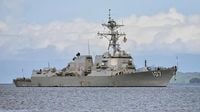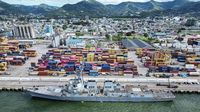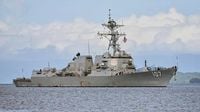The usually tranquil port of Port of Spain, Trinidad and Tobago, became a focal point of international attention on October 26, 2025, as the USS Gravely, a US Navy guided-missile destroyer, docked in the Caribbean nation’s capital. The warship’s arrival, which will see it remain until October 30 for joint training exercises, comes amid escalating tensions between the United States and neighboring Venezuela, casting a spotlight on the region’s delicate geopolitical balance.
The USS Gravely, equipped with advanced weapons systems and capable of deploying helicopters, is no stranger to high-stakes missions. Its recent deployments have included counter-narcotics operations, a priority for the Trump administration, which has ramped up military activity in the Caribbean in recent months. The destroyer’s presence supplements that of the USS Gerald R. Ford, the world’s largest aircraft carrier, which is also moving closer to Venezuelan waters, according to Al Jazeera and Sky News.
Officially, the US Embassy in Trinidad and Tobago describes the joint exercises as a means to “address shared threats like transnational crime and build resilience through training, humanitarian missions, and security efforts,” as stated by Chargé d’Affaires Jenifer Neidhart de Ortiz. The exercises involve the 22nd US Marine Expeditionary Unit and Trinidad and Tobago’s defense forces, aiming to bolster military-to-military cooperation, according to a statement from the country’s Foreign Ministry cited by Axios.
But the arrival of the USS Gravely is anything but routine for the region. Venezuelan President Nicolás Maduro, who was re-elected last year in a contested vote, has repeatedly accused the US of trying to “fabricate a new eternal war” against his country. Speaking through the Venezuelan Foreign Ministry, Maduro’s government condemned the military exercises as a “serious threat” and a “hostile provocation” to the Caribbean region. Venezuelan Vice President Delcy Rodríguez went further, claiming—without offering evidence—that a “false flag attack is underway in waters bordering Trinidad and Tobago or from Trinidadian or Venezuelan territory to generate a full military confrontation with our country.”
These accusations are set against a backdrop of increased US military pressure on Venezuela. President Donald Trump has accused Maduro, again without providing evidence, of being the leader of the organized crime gang Tren de Aragua. This group, designated a terror organization by Washington in February, has been blamed for drug smuggling operations throughout the region. On October 24, the US Secretary of War announced that a strike on a suspected drug boat in the Caribbean Sea had killed six “narco-terrorists,” allegedly linked to Tren de Aragua. President Trump, speaking at a White House news conference, argued that such strikes are necessary to combat the US opioid crisis. “Every boat that we knock out, we save 25,000 American lives. So every time you see a boat, and you feel badly you say, 'Wow, that's rough.' It is rough, but if you lose three people and save 25,000 people,” he said, according to Sky News.
The US’s increasingly muscular posture has not gone unnoticed by regional actors. Trinidad and Tobago’s Prime Minister Kamla Persad-Bissessar has voiced support for the US military presence and the strikes on suspected drug boats near Venezuela. She has argued that the region is not a “zone of peace,” citing high rates of violent crime. However, this stance is far from universally shared. Local opposition groups and ordinary citizens have expressed deep reservations about the warship’s presence. David Abdulah, leader of the Movement for Social Justice political party, led a demonstration outside the US Embassy, declaring, “This is a warship in Trinidad, which will be anchored here for several days just miles off Venezuela when there’s a threat of war. That’s an abomination.”
On the streets of Port of Spain, anxiety is palpable. “If anything should happen with Venezuela and America, we as people who live on the outskirts of it … could end up getting a lash any time,” 64-year-old Daniel Holder told AFP. “I am against my country being part of this.” According to Al Jazeera, many Trinidadians interviewed at a Sunday market voiced fear and uncertainty about what the warship’s docking could mean for their nation.
Trinidad and Tobago’s government, for its part, has sought to reassure the public. The country’s defense minister told Al Jazeera that joint military operations with the US are held regularly and that the USS Gravely’s visit is not a prelude to war. The Foreign Ministry emphasized the longstanding partnership between Trinidad and Tobago and the US, stating, “The visit of the USS Gravely aims to bolster the fight against transnational crime and build resilience through training, humanitarian activities, and cooperation.” The Ministry also underscored the value of the country’s relationship with Venezuela, “given our shared history and close fraternal relations.”
Still, the timing and scale of the US military build-up invite speculation. In August, the US deployed eight navy ships, 10 F-35 warplanes, and a nuclear-powered submarine to the Caribbean, marking the largest military presence in the region since the 1989 invasion of Panama. Javed Ali, a national security expert at the University of Michigan, told Al Jazeera that the US is “projecting a significant amount of military force” to pressure the Maduro regime. However, he noted, “the US military presence is not big enough to launch an invasion of Venezuela. Looking at how the US has conducted wars in the past, it would not be with a small footprint like this.”
The specter of escalation is not lost on US lawmakers. Senator Rick Scott, a close Trump ally, told CBS’s “60 Minutes” that he doubted the US was preparing to invade Venezuela, but suggested that Maduro’s “days are numbered” and advised him to “head to Russia or China right now.” Meanwhile, Senator Lindsey Graham predicted that US strikes in the waters off Venezuela might soon expand to land operations in Venezuela and Colombia, revealing that the Trump administration planned to brief lawmakers on “potential future military operations.”
Venezuela, for its part, is not standing idle. On October 25, Defence Minister Vladimir Padrino announced the start of coastal defense exercises to protect the country against “large-scale military threats.” The government also claimed to have captured a group of mercenaries, allegedly with information from American intelligence, who intended to carry out a false flag attack in the region—though, as with other recent claims, no evidence was provided.
Amid these swirling tensions, the US Embassy in Trinidad and Tobago issued a warning to Americans, urging them to avoid US government facilities due to a reported threat. While details were sparse, the advisory underscored the sense of unease gripping the region.
As the USS Gravely sits anchored just miles from Venezuelan shores, the Caribbean finds itself at the heart of a high-stakes standoff. For now, the warship’s presence is framed as a routine exercise in partnership and security. Yet, for many in Trinidad and Tobago—and across the region—the question lingers: How close is the Caribbean to being drawn into a conflict not of its making?






